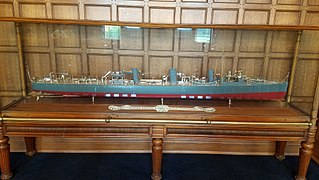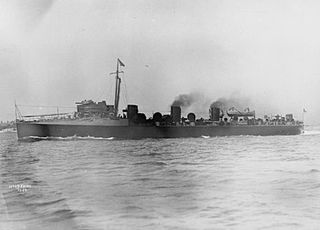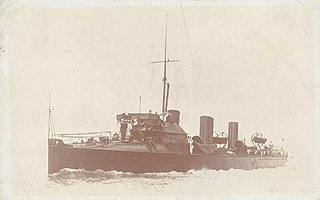Service history
Pre-War
After commissioning she was assigned to the East Coast Flotilla of the 1st Fleet based at Harwich.
She served in the Portsmouth instructional flotilla under the command of Commander Morgan Singer until early January 1901. [5] On 16 December 1901 Flying Fish was re-commissioned by Lieutenant Hugh Percival Buckle for service on the Mediterranean Station, as tender to the battleship Royal Oak. [6] After leaving Devonport for her commission in February 1902, she encountered hard weather in the Bay of Biscay and was knocked about so that she started leaking, and had to port at Brest. She was sufficiently repaired to be able to return to Devonport for more extensive repairs in late February, [7] and eventually arrived at Malta two months late on 16 April 1902. [8] In September 1902 she visited the Aegean Sea with other ships of the station for combined manoeuvres near Nauplia. [9]
On 30 August 1912 the Admiralty directed all destroyer classes were to be designated by alpha characters starting with the letter 'A'. Since her design speed was 30-knots and she had three funnels she was assigned to the C class. After 30 September 1913, she was known as a C-class destroyer and had the letter ‘C’ painted on the hull below the bridge area and on either the fore or aft funnel. [10]
World War I
For the test mobilization in July 1914 Flying Fish was assigned to the 8th Destroyer Flotilla based at Chatham. In August she deployed with the 8th Flotilla to the Tyne River. The destroyer performed patrol duties with the Tyne Patrol including anti-submarine and counter-mining patrols.
In May 1916 when she was deployed to the 7th Destroyer Flotilla based at the Humber River. She performed patrol duties on the Humber Patrol including anti-submarine and counter-mining patrols. She would remain there for the remainder of the war.
In 1919 Flying Fish was paid off and laid-up in reserve awaiting disposal. She was sold on 30 August 1919 to TR Sales for breaking. [11]

HMS Bat was a Palmer-built three funnel, 30 knot torpedo boat destroyer ordered by the Royal Navy under the 1895 – 1896 Naval Estimates. She was the third ship to carry this name since it was introduced in 1815 for a revenue cutter in service until 1848. Bat was classified along with similar vessels as a C-class destroyer in 1913.
HMS Electra was a Clydebank-built, three-funnelled, 30-knot destroyer ordered by the Royal Navy under the 1895–1896 Naval Estimates. She was the fourth ship to carry this name since it was introduced in 1806 for a 16-gun brig-sloop.

HMS Crane was a Palmer three-funnel, 30-knot destroyer ordered by the Royal Navy under the 1895–1896 Naval Estimates. She was the sixth ship to carry this name since it was introduced in 1590 for a 24-gun schooner in service until 1629.
HMS Avon was a Vickers three-funnel, 30-knot destroyer ordered by the Royal Navy under the 1895–1896 Naval Estimates. She was the fifth ship to carry this name since it was introduced in 1805 for an 18-gun brig-sloop, sunk in 1847.

HMS Violet was a Doxford three-funnel, 30-knot destroyer ordered by the Royal Navy under the 1896–1897 Naval Estimates. She was the seventh ship to carry this name since it was introduced in 1588 for a 200-ton vessel.
HMS Sylvia was a Doxford three funnel - 30 knot destroyer ordered by the Royal Navy under the 1896 – 1897 Naval Estimates. She was the sixth ship to carry this name since it was introduced in 1806 for a cutter sold in 1816.

HMS Mermaid was a Hawthorn Leslie three-funnel, 30 knot destroyer ordered by the Royal Navy under the 1896 – 1897 Naval Estimates. She was launched in 1898, served during World War I and was sold for breaking in 1919.

HMS Cheerful was a 30-knot, three-funnel torpedo boat destroyer built by Hawthorn Leslie. She was ordered by the Royal Navy under the 1896–1897 Naval Estimates, launched in 1898, and saw action during World War I. She was mined off the Shetland Islands in 1917 and sank with the loss of 44 officers and men.

HMS Greyhound was a Hawthorn Leslie three-funnel, 30 knot destroyer ordered by the Royal Navy under the 1898 – 1899 Naval Estimates.

HMS Racehorse was a three-funnel, 30-knot torpedo boat destroyer built by Hawthorn Leslie for the Royal Navy. Ordered by the Royal Navy under the 1898–1899 Naval Estimates, she was the eighth ship to carry this name since it was introduced in 1757. She served in World War I and was sold for breaking in 1920.
HMS Osprey was a three-funnel, 30-knot destroyer ordered by the Royal Navy under the 1896–1897 Naval Estimates from Fairfields. She was the fifth ship to carry this name since it was introduced in 1797 for an 18-gun ship-sloop.

HMS Gipsy was a Fairfield-built three-funnel, 30 knot torpedo boat destroyer ordered by the Royal Navy under the 1896 – 1897 Naval Estimates. She was the fourth ship to carry this name. Designated as a C-class destroyer in 1913, Gipsy served on patrol in the First World War operating out of Dover. She was sold for breaking in 1921.

HMS Bullfinch was a three-funnel, 30-knot destroyer ordered by the Royal Navy under the 1896–1897 Naval Estimates. She was the third ship to carry this name since it was introduced in 1857 for a 4-gun wooden-screw gunboat.

HMS Cynthia was a two funnel, 30-knot destroyer ordered by the Royal Navy under the 1896 – 1897 Naval Estimates. She was the third ship to carry this name. She was launched in 1898, served in home waters and the Mediterranean before World War I, and as a tender to the gunnery school at Sheerness during the war. She was sold for breaking in 1920.

HMS Fawn was a Palmer three funnel, 30 knot destroyer ordered by the Royal Navy under the 1896 – 1897 Naval Estimates. She was the fourth ship to carry this name.
HMS Vixen was a Vickers three funnel - 30 knot destroyer ordered by the Royal Navy under the 1895 – 1896 Naval Estimates. She was the fourth ship to carry this name since it was introduced in 1801 for an 18-gun brig sold 1815.
HMS Brazen was a Clydebank three-funnel, 30-knot destroyer ordered by the Royal Navy under the 1895-1896 Naval Estimates. She was the fifth ship to carry this name since it was introduced in 1781 for a 14-gun cutter, sold in 1799.

HMS Thorn was a Clydebank three funnel - 30 knot destroyer purchased by the Royal Navy under the 1899–1900 Naval Estimates. She was the second ship to carry this name since it was introduced in 1779 for a 16-gun sloop sold in 1816.

HMS Falcon was a Fairfield three-funnel, 30 knot destroyer ordered by the Royal Navy under the 1898 – 1899 Naval Estimates. She spent her life in Home waters, was part of the Dover Patrol during World War I and was lost in a collision on 1 April 1918.

HMS Albatross was an experimental torpedo boat destroyer of the Royal Navy authorised under the 1896–97 Naval Estimates and built by John I. Thornycroft & Company of Chiswick on the River Thames. She was contracted to be faster, larger and more powerful than existing designs.
This page is based on this
Wikipedia article Text is available under the
CC BY-SA 4.0 license; additional terms may apply.
Images, videos and audio are available under their respective licenses.












